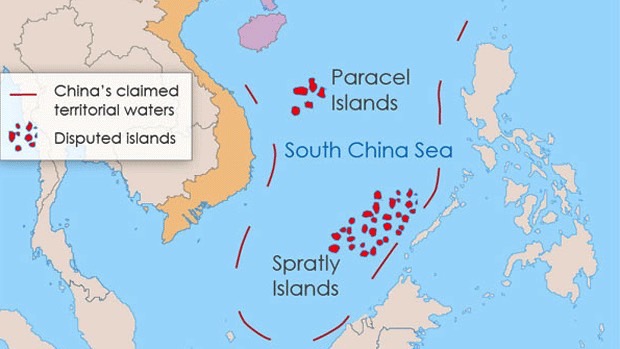
By Graeme Dobel*
Deputy Prime Minister and Defence Minister Richard Marles talks about the ‘West Philippine Sea’, not just the ‘South China Sea’. Kicking away some of the dashes in China’s nine-dash line claiming the whole of the South China Sea certainly pokes the dragon. (The Australian Strategic Policy Institute. The Strategist.)
The ‘West Philippine Sea’ was first used by Manila in 2011 in expressing its disagreement with Beijing’s claim. The ‘West Philippine Sea’ refers only to waters in the Philippines’ 200-nautical-mile exclusive economic zone, not the whole of the South China Sea.
Australia’s previous Liberal-National Party government stuck to using only the ‘South China Sea’ in its dealings with the Philippines. Marles shifted usage during his visits to the Philippines last year. At a press conference in Zambales in August, Marles referred to the importance of Manila’s victory over Beijing in the arbitral award under the UN Law of the Sea: ‘The 2016 arbitral award is profoundly important in terms of what it says about the West Philippine Sea and we support the 2016 arbitral award.’
In May this year in Hawaii, Marles joined defence ministers from the US, Japan and the Philippines in saying that ‘they strongly objected to the dangerous use of coast guard and maritime militia vessels in the South China Sea. They reiterated serious concern over the People’s Republic of China’s repeated obstruction of Philippine vessels’ exercise of high seas freedom of navigation and the disruption of supply lines to Second Thomas Shoal, which constitute dangerous and destabilizing conduct.’
The statement pledged maritime cooperation in the Philippines’ EEZ but did not refer to the West Philippine Sea, reflecting caution by both Japan and the US. In backing its treaty ally, the Philippines, the United States has avoided the ‘West Philippine Sea’ phrase.
Not so Marles, who told the Hawaii press conference of the ‘challenge to the global rules‑based order in the East China Sea, in the South China Sea, in the West Philippine Sea. And our four countries are utterly committed to asserting freedom of navigation, to asserting the UN Convention on the Law of the Sea, to asserting the global rules‑based order around the oceans of the world, including in the West Philippine Sea.’
At the Shangri-La dialogue in Singapore at the weekend, Marles questioned China’s strategic behaviour and the signals it sent, offering this as his first example: ‘Actions by Chinese vessels in the West Philippine Sea, such as the use of water cannons and the ramming of Philippine vessels, are a serious escalation of tensions and inconsistent with UNCLOS and the final and binding 2016 South China Sea arbitration ruling.’
Two of the strongest speeches attacking Chinese behaviour were from Marles and the keynote address from the Philippines’ President Ferdinand Marcos Junior.
Marcos said China aimed to ‘propagate excessive and baseless claims through force, intimidation, and deception. In the West Philippine Sea, we are on the frontlines of efforts to assert the integrity of the UNCLOS as a Constitution of the Oceans. We have defined our territory and maritime zones in a manner befitting a responsible and law-abiding member of the international community. We have submitted our assertions to rigorous legal scrutiny by the world’s leading jurists. So, the lines that we draw on our waters are not derived from just our imagination, but from international law.’
The response from Chinese Defence Minister Admiral Dong Jun was to claim that the Philippines, backed by the US, had ‘abandoned bilateral agreements, broken its promises, and taken premeditated action to stir up incidents’. China’s restraint, he said, ‘has its limits’.
Canberra embraces Marcos far more than it did his predecessor, Rodrigo Duterte. The warmth is encouraged by a consensus in Manila that Duterte’s attempt to cosy up to China failed. Duterte tried to play nice; Beijing kept playing nasty. Tough talk from Marcos rhymes with much coming from Canberra.
Prime Minister Albanese visited Manila in September and welcomed Marcos to Canberra in February. Albanese called the Philippines a close friend and strategic partner: ‘Australia sees the Philippines as a central player and a crucial partner for us in Southeast Asia.’
Marcos says that as a senator he was a co-sponsor of an Archipelagic Baselines Law, which defines the basis of the Philippines’ maritime jurisdiction. As president, he intends to sign ‘a Maritime Zones Law, which will clarify the geographic extent of our maritime domain’.
Australia’s call on that domain definition is in. Australia is the second country, after the US, to commit to joint patrols with the Philippines in its waters.
Adopting the notion of the West Philippine Sea, Australia embraces a geographic term that has found little favour with countries other than the Philippines in the Association of South East Asian Nations. The ASEAN language of neutrality and non-alignment trumps solidarity with the Philippines. It’s the South China Sea to ASEAN members—apart from Vietnam, which calls it the East Sea.
The Marcos administration is getting more explicit support on the West Philippine Sea from Australia than it does from ASEAN.
Sticking with the Philippines’ map, Australia is sticking it to China. That’s a pointy schtick.



